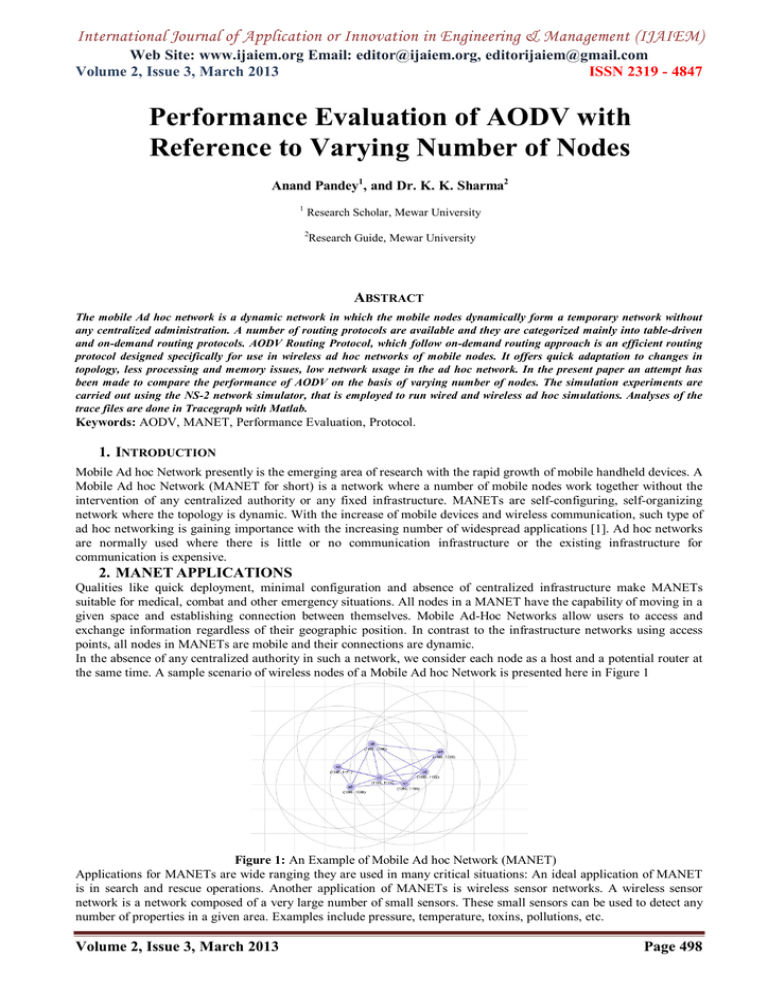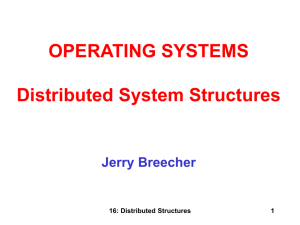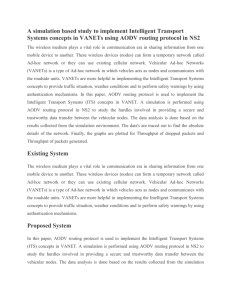Performance Evaluation of AODV with Reference to Varying Number of Nodes
advertisement

International Journal of Application or Innovation in Engineering & Management (IJAIEM) Web Site: www.ijaiem.org Email: editor@ijaiem.org, editorijaiem@gmail.com Volume 2, Issue 3, March 2013 ISSN 2319 - 4847 Performance Evaluation of AODV with Reference to Varying Number of Nodes Anand Pandey1, and Dr. K. K. Sharma2 1 Research Scholar, Mewar University 2 Research Guide, Mewar University ABSTRACT The mobile Ad hoc network is a dynamic network in which the mobile nodes dynamically form a temporary network without any centralized administration. A number of routing protocols are available and they are categorized mainly into table-driven and on-demand routing protocols. AODV Routing Protocol, which follow on-demand routing approach is an efficient routing protocol designed specifically for use in wireless ad hoc networks of mobile nodes. It offers quick adaptation to changes in topology, less processing and memory issues, low network usage in the ad hoc network. In the present paper an attempt has been made to compare the performance of AODV on the basis of varying number of nodes. The simulation experiments are carried out using the NS-2 network simulator, that is employed to run wired and wireless ad hoc simulations. Analyses of the trace files are done in Tracegraph with Matlab. Keywords: AODV, MANET, Performance Evaluation, Protocol. 1. INTRODUCTION Mobile Ad hoc Network presently is the emerging area of research with the rapid growth of mobile handheld devices. A Mobile Ad hoc Network (MANET for short) is a network where a number of mobile nodes work together without the intervention of any centralized authority or any fixed infrastructure. MANETs are self-configuring, self-organizing network where the topology is dynamic. With the increase of mobile devices and wireless communication, such type of ad hoc networking is gaining importance with the increasing number of widespread applications [1]. Ad hoc networks are normally used where there is little or no communication infrastructure or the existing infrastructure for communication is expensive. 2. MANET APPLICATIONS Qualities like quick deployment, minimal configuration and absence of centralized infrastructure make MANETs suitable for medical, combat and other emergency situations. All nodes in a MANET have the capability of moving in a given space and establishing connection between themselves. Mobile Ad-Hoc Networks allow users to access and exchange information regardless of their geographic position. In contrast to the infrastructure networks using access points, all nodes in MANETs are mobile and their connections are dynamic. In the absence of any centralized authority in such a network, we consider each node as a host and a potential router at the same time. A sample scenario of wireless nodes of a Mobile Ad hoc Network is presented here in Figure 1 Figure 1: An Example of Mobile Ad hoc Network (MANET) Applications for MANETs are wide ranging they are used in many critical situations: An ideal application of MANET is in search and rescue operations. Another application of MANETs is wireless sensor networks. A wireless sensor network is a network composed of a very large number of small sensors. These small sensors can be used to detect any number of properties in a given area. Examples include pressure, temperature, toxins, pollutions, etc. Volume 2, Issue 3, March 2013 Page 498 International Journal of Application or Innovation in Engineering & Management (IJAIEM) Web Site: www.ijaiem.org Email: editor@ijaiem.org, editorijaiem@gmail.com Volume 2, Issue 3, March 2013 ISSN 2319 - 4847 3. ROUTING IN MOBILE AD HOC NETWORK An ad-hoc network is a collection of wireless mobile hosts forming a temporary network without the aid of any standalone infrastructure or centralized administration [2]. Mobile Ad-hoc networks are self-organizing and self-configuring multi-hop wireless networks, where the topology of the network changes dynamically. This is mainly due to the unpredictable mobility of the node [3]. Nodes in these networks utilize the same wireless channel and engage themselves in multi-hop forwarding. The nodes in this network not only act as hosts but also as routers that route the data from/to other nodes in network [4]. Classification of routing protocols in MANET’s can be done on the basis of routing strategy and network structure [3, 5]. According to the routing strategy the routing protocols can be categorized into Table-Driven and Source-Initiated protocols, while on the basis of the network structure these protocols are classified as flat routing, hierarchical routing and geographic position assisted routing [3]. Flat routing protocols are of two types; proactive routing (table driven) protocols and reactive (on-demand) routing protocols. They further can be classified according to their design principles; proactive routing follows LS strategy (link state) while on-demand routing follows DV (distance-vector). Proactive protocols continuously learn the topology of the network by exchanging topological information among the regular nodes. Thus, when there is a need for a route the data to a particular destination, such route information is available immediately [6]. Hence there is minimum delay in determining the route to be chosen which is important for time-critical traffic. Proactive protocols suits well in networks where the nodes transmit data frequently and have low node mobility. Examples of Proactive MANET Protocols include: • Optimized Link State Routing, or OLSR [7] • Topology Broadcast based on Reverse Path Forwarding, or TBRPF [8] • Fish-eye State Routing, or FSR [9] • Destination-Sequenced Distance Vector, or DSDV [10] • Landmark Routing Protocol, or LANMAR [11] • Clusterhead Gateway Switch Routing Protocol, or CGSR [12] Reactive / On Demand routing is a relatively new routing style that provides solution to relatively large network topologies. These protocols are based on some sort of query-reply packet exchange. In this type of routing there is no need of periodic transmission of topological information. Common for most on-demand routing protocols are the route discovery phase where packets are flooded into the network in search of an optimal path to the destination node in the network. Examples of Reactive MANET Protocols include: • Ad hoc On-Demand Distance Vector, or AODV [17] • Dynamic Source Routing, or DSR • Temporally Ordered Routing Algorithm, or TORA 4. AD HOC ON-DEMAND DISTANCE VECTOR ROUTING (AODV) Ad Hoc On-Demand Distance Vector Routing [17] is an improvement over Dynamic Destination-Sequenced DistanceVector Routing Protocol, but, AODV is a reactive routing protocol instead of proactive. When a source node has some packet to be sent to a destination, it broadcasts a control packed viz. Route Request (RREQ) packet, which is flooded in the deployment area. During the process of forwarding the RREQ packet, intermediate nodes record the address of the neighbor from which the first copy of the RREQ packet is received. This record is stored in their routing tables, which helps in establishing a path to back track. If additional copies of the same RREQ packet are received later, these packets are discarded. The Route Reply message is sent using the reverse path. If any intermediate node of a MANET moves, the neighbor of the shifted node can detect the link failure and sends a notification of link failure to its upstream neighbor. This route maintenance process continues until the failure notification reaches the source node. Based on this information about the current topology, the source might decide to initiate the route discovery process again. 5. SIMULATION OF ROUTING PROTOCOL Simulation of the AODV routing protocol has been done to evaluate the performance of the network with respect to the varying number of nodes. Various network parameters that are taken for the simulation are listed in Table 1. Table 1: Network Parameter Definition Parameter Name Value Channel Type Channel/Wireless Channel Netif Phy/Wireless Phy Volume 2, Issue 3, March 2013 Page 499 International Journal of Application or Innovation in Engineering & Management (IJAIEM) Web Site: www.ijaiem.org Email: editor@ijaiem.org, editorijaiem@gmail.com Volume 2, Issue 3, March 2013 ISSN 2319 - 4847 Mac Protocol Mac/802_11 Queue Length 50 Number of Nodes 3/6/9/12/15 Routing Protocol AODV Grid Size 500 x 400 Packet Size 512 Simulation Time 50 Topology Random 6. RESULTS, PERFORMANCE EVALUATION & ANALYSIS Experiments are carried out in Network Simulator 2 (NS2 [16]) with programming done in Tcl script language. Two output files with *. nam and *.tr extension were further analyzed. NAM is a Tcl/TK based animation tool for viewing network simulation traces and real world packet traces. NAM supports topological layout, packet level animations, and various data inspection tools. Trace files (with *. tr extension) can be analyzed by tracegraph [15] tool that runs within Matlab. We also evaluate the performance of AODV by varying the number of nodes. We are able to analyze the simulation of AODV with different number of nodes, with the help of 2D and 3D graphs generated with tracegraph. The simulation is divided in five parts based on the number of nodes that vary: AODV with 3 nodes. AODV with 6 nodes. AODV with 9 nodes. AODV with 12 nodes. AODV with 15 nodes. The comparison of performance of AODV, based on the number of nodes is done on following parameters like packet sent, packet received, packet dropped, packets lost, packets forwarded, throughput and average end-to-end delay, Normalized Routing Load, Jitter, and Packet Delivery Fraction. 7. COMPARISON OF PERFORMANCE OF AODV BASED UPON NUMBER OF NODES As we increase the number of nodes for performing the simulation of AODV protocol, number of sent and delivered packets changes, which results in a change in throughput and average end-to-end delay. Throughput is defined as the ratio of data delivered to the destination to the data sent by the sources. Average end-to-end delay is the average time a packet takes to reach its destination. The table II shows the difference between sent packets, received packets, lost and dropped packets, the average end-to-end delay when the number of nodes is increased. Packet Size---------------------- 512 Simulation Time---------------- 150 Sec Table 2: Comparison of Various Parameters v/s No. of Nodes No of Nodes Parameters 3 6 9 12 15 Packets Sent 21680 22296 22086 22866 22538 20979 21206 20427 19923 19457 1489 1444 1731 1492 1212 0.003 0.025 0.093 0.257 0.544 0.9677 0.951 1 0.924 9 0.8908 0.8633 Packets Received Packets Forwarded NRL PDF Volume 2, Issue 3, March 2013 Page 500 International Journal of Application or Innovation in Engineering & Management (IJAIEM) Web Site: www.ijaiem.org Email: editor@ijaiem.org, editorijaiem@gmail.com Volume 2, Issue 3, March 2013 ISSN 2319 - 4847 Throughput 641.89 Jitter1 134.34 Jitter 2 134.68 641.9 8 513.4 6 470.8 2 618.6 3 1058. 7 975.2 3 612.81 600.03 1198.7 7 1083.8 0 1428.0 8 1290.6 0 The data in Table 2 are plotted in MS Excel Figure 2: Plot of Packets Sent against no. of Nodes Fig. 2 shows the total number of packets sent vary with increasing number of nodes. As the number of nodes goes on increasing, the packets sent first increases then decreases and as no. of nodes becomes 9 it only increases. Figure 3: Plot of Packets Received against no. of Nodes Fig. 3 shows the graphical representation of Packet Received versus number of nodes of AODV protocol. As the number of nodes goes on increasing, the number of packets sent decreases. Figure 4: Plot of Packets Forwarded against no. of Nodes Volume 2, Issue 3, March 2013 Page 501 International Journal of Application or Innovation in Engineering & Management (IJAIEM) Web Site: www.ijaiem.org Email: editor@ijaiem.org, editorijaiem@gmail.com Volume 2, Issue 3, March 2013 ISSN 2319 - 4847 Figure 4 shows the graphical representation of Packet Forwarded versus the number of nodes of AODV protocol. As the number of nodes goes on increasing, the number of packets forwarded decreases. Figure 5: Plot of Packets NRL against no. of Nodes NRL= Number of Routing Packets Sent Number of Data Packets Received Figure 5 shows the graphical representation of Normalized Routing Load versus the number of nodes of AODV protocol. As the number of nodes goes on increasing, the NRL value increases. Figure 6: Plot of PDF against no. of Nodes PDF= Number of Received Packets Number of Sent Packets Figure 6 shows the graphical representation of PDF versus the number of nodes of AODV protocol. As the number of nodes goes on increasing, the PDF value decreases. Figure 7: Plot of Packets Received against no. of Nodes Figure 7 shows the graphical representation of Throughput versus the number of nodes of AODV protocol. As the number of nodes goes on increasing, the Throughput value decreases. Volume 2, Issue 3, March 2013 Page 502 International Journal of Application or Innovation in Engineering & Management (IJAIEM) Web Site: www.ijaiem.org Email: editor@ijaiem.org, editorijaiem@gmail.com Volume 2, Issue 3, March 2013 ISSN 2319 - 4847 Figure 8: Plot of Packets Jitter 1 against no. of Nodes Figure 9: Plot of Jitter 2 against no. of Nodes Figure 8 and 9 show the graphical representation of jitter versus the number of nodes of AODV protocol. As the number of nodes goes on increasing, the jitter increases. Figure 12: Plot of Packets Received against no. of Nodes REFERENCES [1] Sarangapani, Jagannathan, “Wireless ad hoc and sensor networks: Protocols, Performance and Control”, CRC Press. [2] Xiaoyan Hong, Kaixin Xu, and Mario Gerla. “Scalable routing protocols for mobile ad hoc networks”, 2002. [3] Mehran Abolhasan, Tadeusz Wysocki, and Eryk Dutkiewicz, “A review of routing protocols for mobile ad hoc networks”, Technical report, Telecommunication and Information Research Institute, University of Wollongong, Wollongong, NSW 2522; Motorola Australia Research Centre, 12 Lord St., Botany, NSW 2525, Australia, 2003. [4] Laura Marie Feeney, “A taxonomy for routing protocols in mobile ad hoc networks”, Technical report, Swedish Institute of Computer Science, Sweden, 1999. Volume 2, Issue 3, March 2013 Page 503 International Journal of Application or Innovation in Engineering & Management (IJAIEM) Web Site: www.ijaiem.org Email: editor@ijaiem.org, editorijaiem@gmail.com Volume 2, Issue 3, March 2013 ISSN 2319 - 4847 [5] Dr. Uwe Roth, “Highly dynamic destination-sequenced distance-vector routing”,http://wiki.uni.lu/secanlab/Highly+Dynamic+Destination-Sequenced+Distance-Vector+Routing.html. [6] Al-Sakib Khan Pathan and Choong Seon Hong, "Routing in Mobile Ad Hoc Networks", Guide to Wireless Ad Hoc Networks, Springer (London), (Edited by Sudip Misra, Isaac Woungang, and Subhas Chandra Misra), ISBN 9781-84800-327-9, 2009, pp. 59-96 [7] P. Jacquet, P. Muhlethaler, A. Qayyum, A. Laouiti, L. Viennot and T. Clausen, “Optimized Link State Routing Protocol”, Internet Draft, IETF MANET Working Group, draft-ietf-manet-olsr-04.txt, Mar. 2002. [8] R. G. Ogier, F. L. Templin, B. Bellur, M. G. Lewis, “Topology Broadcast Based on Reverse-Path Forwarding (TBRPF)”, Internet Draft, IETF MANET Working Group, draft-ietf-manet-tbrpf-05.txt, Mar. 2002. [9] G. Pei, M. Gerla, and T.-W. Chen, “Fisheye State Routing in Mobile Ad Hoc Networks”, Proceedings of Workshop on Wireless Networks and Mobile Computing, Taipei, Taiwan, Apr. 2000. [10] Perkins, C.E., and P. Bhagwat, “Highly dynamic destination sequenced distancevector routing (DSDV) for mobile computers:, Computer Communications Review,1994, pp. 234–244. [11] P. F. Tsuchiya, “The Landmark Hierarchy: a new hierarchy for routing in very large networks”, Computer Communication Review, vol.18, no.4, Aug. 1988, pp. 35-42. [12] Ching -Chuan Chiang, Hsiao-Kunag Wu, Winston Liu and Mario Gerla, “Routing in Clustered Multihop, Mobile Wireless Networks with Fading Channel,” IEEE Singapore [13] Perkins CE, Royer EM, Chakeres ID (2003) Ad hoc On-Demand Distance Vector (AODV) Routing. IETF Draft, October, 2003, available at http://tools.ietf.org/html/draft-perkins-manet-aodvbis-00. Accessed 21 February 2008 [14] Broch J, Johnson DB, Maltz DA (1999) The Dynamic Source Routing Protocol for Mobile Ad Hoc Networks. IETF Draft, October, 1999, available at http://tools.ietf.org/id/draft-ietf-manet-dsr-03.txt. [15] Tracegraph http://www.tracegraph.com/download.html [16] S.McCanne and S.Floyd,”Network Simulator”, http://www.isi.edu/nsnam/ns/ [17] C. Perkins, E. Belding-Royer, S. Das. Ad hoc On-Demand Distance Vector (AODV) Routing. Feb. 2003. http://www.ietf.org/internet-drafts/draftietf-manet-aodv-13.txt. Volume 2, Issue 3, March 2013 Page 504





